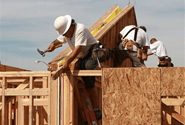Steel Markets

Housing Starts and Permit Authorizations Tumble in February
Written by Sandy Williams
March 17, 2021
Housing starts tumbled to a six-month low in February to a seasonally adjusted annual rate of 1.421 million, according to the U.S. Department of Housing and Urban Development and the U.S. Census Bureau. Starts were 10.3% below January’s rate and down 9.3% from February 2020. Part of the decline was due to the unusual winter weather across Texas and the South that stalled construction and supply chains.
Single-family home starts dropped 8.5% from January to February to a SAAR of 1.04 million. Multifamily housing of five units or more plunged 14.6% month-over-month. Despite falling numbers for February, single-family starts are trending upward from a year ago.
“While single-family starts for the first two months of the year are 6.4% higher than the first two months of 2020, there has been a 36% gain over the last 12 months of single-family homes permitted but not started, as some projects have paused due to cost and availability of materials,” said Robert Dietz, chief economist at the National Association of Home Builders.
Permit authorization for new homes fell 10.8% to a 1.68 million annualized rate in February. Single-family permits were down 10.0% and multifamily permits 12.5%.
“Despite strength in buyer traffic and lack of existing inventory, builders are slowing some production of single-family homes as lumber and other material costs, along with interest rates, continue to rise,” said Chuck Fowke, NAHB chairman. “Shortages of lumber and other building materials, including appliances, are putting future construction expansion at risk.”
Soaring lumber prices have added approximately $24,000 to the price of a new home, said Dietz.
The NAHB/Wells Fargo Housing Market Index (HMI), released this week, shows builder confidence wavering slightly for newly built-single family homes, falling two points to 82 in March. “Builder confidence peaked at a level of 90 last November and has trended lower as supply-side and demand-side factors have trimmed housing affordability,” said Dietz.
The HMI index for current sales expectations fell three points to 87, while future sales expectations in the next six months increased three points to 83. Existing-home inventory remains tight, which should benefit the new construction market.

Sandy Williams
Read more from Sandy WilliamsLatest in Steel Markets

CMC looks beyond Arizona micro-mill woes to long-term viability of construction mart
Despite the economic and geopolitical upheaval of the last five years, CMC President and CEO Peter Matt points out that the construction market has been an essential element of the way forward.

US importers face stricter rules under revamped S232 tariffs
“CBP expects full compliance from the trade community for accurate reporting and payment of the additional duties. CBP will take enforcement action on non-compliance," the agency said in a March 7 bulletin.

Steel exports rebound in January
US steel exports recovered to a five-month high in January after having fallen to a two-year low in December. This growth follows four consecutive months of declining exports.

Construction spending drops marginally in January
Construction spending edged down slightly in January, slipping for the first time in four months. The US Census Bureau estimated spending at a seasonally adjusted annual rate of $2,196 billion in January, down 0.2% from December’s downward revised rate. The January figure is 3.3% higher than a year ago. January’s result, despite the slight erosion, […]

HVAC equipment shipments slow in December but strong annually
Shipments of heating and cooling equipment in the US fell to an 11-month low in December, according to the latest data released by the Air-Conditioning, Heating, and Refrigeration Institute (AHRI).
